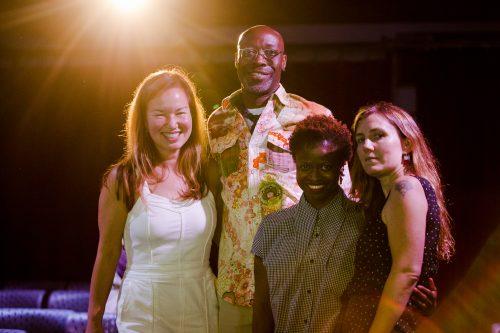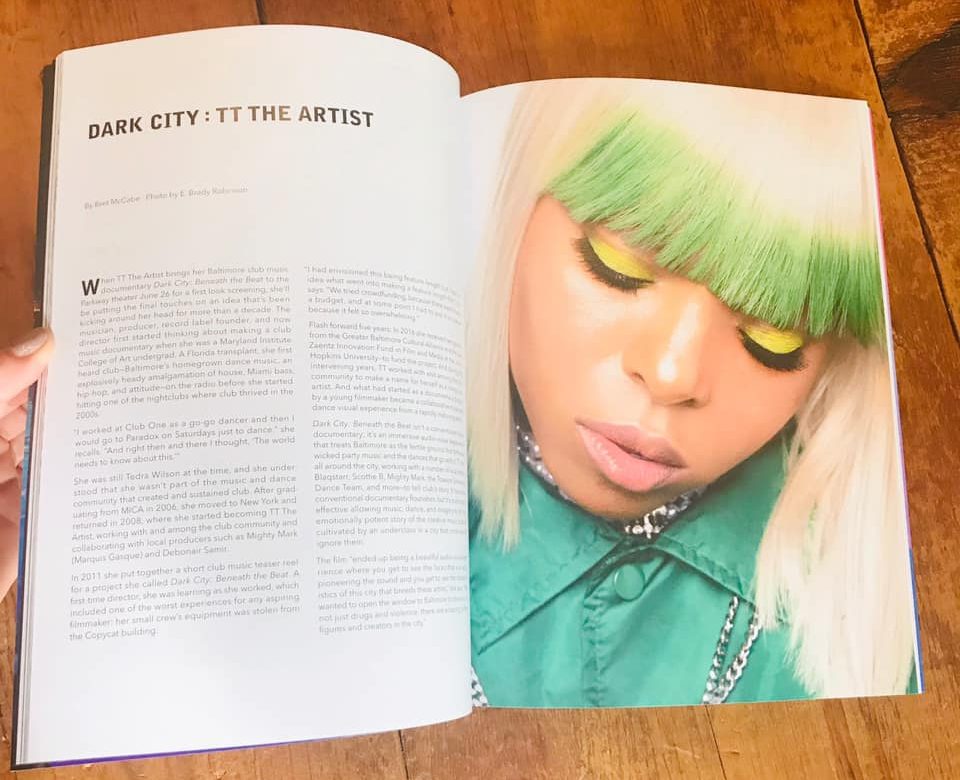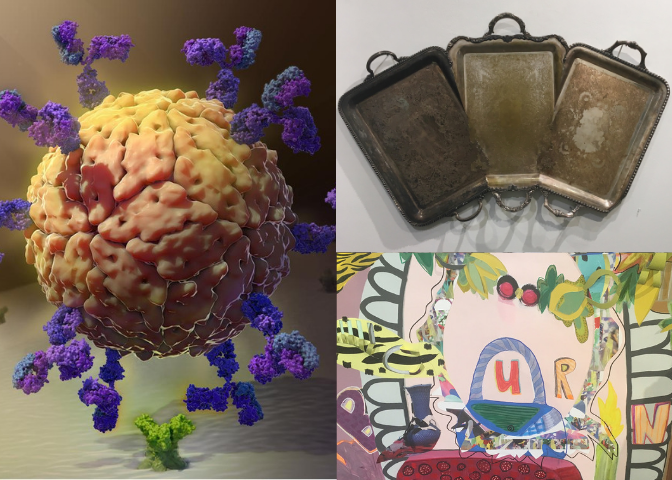This week: You’d be surprised at what someone can do with a set of flatware at the Baltimore Jewelry Center’s Appetites and Objects; glimmering excesses in Amy Boone-McCreesh’s installation at Creative Alliance; and Vondel Mahon’s skillful and beautiful scientific illustrations remind us to look below the surface.
 Erin Daily, “Dent,” sterling silver
Erin Daily, “Dent,” sterling silver

Appetites and Objects, through July 12
Baltimore Jewelry Center, 10 E. North Ave., Suite 130, Baltimore 21202
Gallery Hours: Monday & Tuesday, 1–10 p.m.; Wednesday & Thursday, 10 a.m.–10 p.m.; Friday, 10 a.m.–3 p.m.; Saturday & Sunday, noon–6 p.m.
Kitchen utensils are usually a means to an end. What’s the point of a fork and knife if not to eat? But purpose is beside the point in Appetites and Objects, a show in which everyday tools are reduced to their raw materials with little regard for practicality. An aluminum spoon by Kristy Bujanic sputters and melts, its blob appendage attached like a misshapen sixth toe. Three silver-plated platters collide together in a tarnished triptych by Jaydan Moore. And John William Huckins’s brass ladle sits double-sided—one deep spoon on each end—with no handle.
Co-juried by April Wood and Rosemary Liss, the show is up at the Baltimore Jewelry Center (BJC) through July 12 and features work by 26 international artists. I was disappointed that out of all 26, only one, Hannah Brill, is from Baltimore, and except for a couple others, regional talent is not represented here. However, all the work included succeeds in its focus on material over utility. Some tools are simply elegant objects. I could imagine the steel and copper utensil set by Amy Weiks and Gabriel Craig hanging in an ancient French kitchen. The silver pitcher and tumblers by Kaminer Haislip shine like a Cadillac. Other pieces are whimsical, such as a miniature ironing board by Brill, or a silver-set enamel pin painted with peaches by Zouella Jarman.
My favorite works are the ones that suggest an ugly origin or an aggressive gesture. A set of spoons by Erin Daily is indented with bite marks, fixed in sterling silver. Ten small objects by Stuart Cain are at once the most delicate and menacing entries in the show—one looks like a toothbrush, with nails for bristles; another looks like a shiv.
Bringing the domestic (and its gendered connotations) into a gallery setting is hardly a novel idea at this point, but the charm of Appetites and Objects lies in its playfulness. In toeing the delicate line between art and craft, it urges me to consider the process of metalsmithing—the heating, melting, and moving between states of matter—and how such a brutal process can result in something so beautiful as sterling silver, or so practical as a fork and knife. (Nora Belblidia)
 Amy Boone-McCreesh, “Everything We Own,” mixed media on cut paper (2019)
Amy Boone-McCreesh, “Everything We Own,” mixed media on cut paper (2019)
 Amy Boone-McCreesh, “Twin Set” (detail), custom printed fabric, foam, acrylic, mixed media (2018)
Amy Boone-McCreesh, “Twin Set” (detail), custom printed fabric, foam, acrylic, mixed media (2018)
Amy Boone-McCreesh: More or Less, through June 22
Creative Alliance, 3134 Eastern Ave., Baltimore 21224
Gallery Hours: Tuesday–Saturday, 11 a.m.–7 p.m.
I saw this meme the other day—a photo of a room cluttered with a hoarder’s haul, captioned with a challenge: “Name one thing in this photo.” Zooming in with a pinch of my fingers, every object I’d presumed to recognize—an earring display rack, a string of lights, a pile of laundry, some wrapping paper, an inexplicable bear—quickly became a fuzzy mess.
The centerpiece of Amy Boone-McCreesh’s show at the Creative Alliance’s Amalie Rothschild gallery exhibits a similar bewildering profusion. “Everything We Own,” a wall-sized collage of cut paper and paint, is loud, with shades of bubblegum, mint, and periwinkle screaming against the quieter, more domestic-neutral taupe, beige, buff, and mustard shapes. Among this cacophony I can discern a window, a large urn, a short doric column, and maybe an ottoman. The rest is a wash. Just as I keep wanting to pull recognizable objects out of the ruckus, my eyes search for a guide or a walkway through this piece—what seem like window curtains, furniture, and familiar patterns signify a room—but there’s no depth or path, just surface-level mass. The entrancing too-much-ness of all these objects and decorative elements is just the point, mirroring some of the effects of capitalism, consumerism, wealth: an obsession with things of a certain quality and refined taste (whatever “taste” even is, or however it’s transmitted and transmuted via pop culture and media).
Bookending this work, and a couple of the others, are columns painted flat on the wall, to scale with the art objects—the columns are simple forms of yellow and pink, like enormous pencils, with dripping gloop affixing them to their bases, simulating “high-class” in basic form but not function. (Now I’m thinking about McMansion architecture.) Feathery garlands strung with shiny, glittery, translucent cut-outs of various bright colors and patterns appear throughout as well, gleaming and dangling like big keychain charms, or otherwise recalling those musty DIY silk floral garlands sold at craft stores, only more glamorous.
I’ve long appreciated the way that Boone-McCreesh (an occasional BmoreArt contributor) can overwhelm the viewer with her intricate maximalism, material frills mixed with shocks of color—so I was a little disappointed that her work in this space felt smaller than it actually is. Most of the pieces in this show are on the wall, but even the sculptural ones sit close to the wall, rather than engaging the whole room. The artist’s shapes and patterns are so specific that they beckon you over, then command your attention further, but I wanted it to be more of an overall dizzying immersion, like walking into a Macy’s but worse, rather than being able to hop in and out of the chaos, from one piece to the next. After all, we can’t simply hop in and out of our soul-deadening, virulent capitalist culture. Or can we? (Rebekah Kirkman)
 Vondel Mahon,”Tail Feathers Of The Mot Mot” (detail), mixed media (2018)
Vondel Mahon,”Tail Feathers Of The Mot Mot” (detail), mixed media (2018)
 Vondel Mahon, “Hip Bone,” graphite dust
Vondel Mahon, “Hip Bone,” graphite dust
When Art Meets Science: The Artistry of Medical Illustration, through June 22
Gallery 1448, 1448 E. Baltimore St., Baltimore 21231
Closing Reception: June 22, 1–4 p.m., artist talk at 2 p.m.
Gallery Hours: by appointment; contact Vondel Mahon at [email protected], (443) 636-0631
A cursory look at Grenada-born Vondel Mahon’s work reveals an inquisitive, scholarly eye that translates across various media—pencil drawings, graphic and 2-D illustrations, animations, and digital 3-D models are all on display in his solo show When Art Meets Science: The Artistry of Medical Illustration. Fresh out of the MA in Medical and Biological illustration at Johns Hopkins, Mahon provides those unfamiliar with the world of medical illustration a succinct idea of the vast amount of research that goes into this specialty, not to mention the time-consuming process and execution of the final illustrations.
Observational drawing forms the backbone of much of the work on display. Stunning black and white figure studies stand alongside colored, ready-for-publication digital illustrations of internal organs and musculature, connecting the inside and outside of bodies that we’re trying constantly to maintain, improve upon, heal, and cure. Mahon’s repertoire moves beyond the human too, with larger-than-life, beautifully shaded graphite studies of bird skulls, with the original specimens displayed alongside for scale.
Moving from these hand-drawn sketches and studies to the screens featuring 3-D models and videos that explore the insides of the human body for elaborate, intricate medical procedures, it is striking that so much of what’s inside of us is visually inaccessible. Outside of the living flesh and skin that we see, not many of us spare a thought for the vast, complicated worlds that exist within us. If you thought it was difficult to conjure up an image of what the inside of a penis looks like, for instance, fear not—Mahon has a whole illustrated segment for a surgical procedure on the organ. It’s fascinating, and very unlike the sickly, pink-tinted drawings from biology classes. Mahon’s work hits a spot that most of us can identify with—appreciation of something beautiful, and then the intrigue of everything we hadn’t considered about it. (Priyanka Kumar)
The Friday Gallery Roundup is a curated compilation of three short reviews of three current exhibitions worth your time and consideration. There’s much to see and do in this town every day—check out our calendar and weekly picks for even more options—but here’s a list of shows you can check out now.
Featured image (clockwise from left): Vondel Mahon, “Tick-Born Encephalitis Virus”; Jaydan Moore, “Specimen #23”; Amy Boone-McCreesh, “Everything We Own” (detail)
Photos by the authors except Vondel Mahon’s “Tail Feathers Of The Mot Mot” and “Tick-Born Encephalitis Virus” which are courtesy of Gallery 1448.






